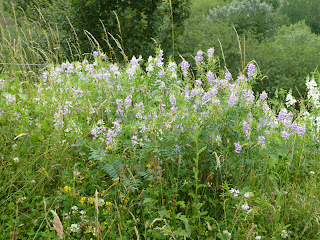We took the "pretty route" as Malcolm navigated, and eventually arrived in the car park around 11.00 am, without a feather being seen!
 |
| Grey Heron |
From the David Feast Hide we watched a further grey heron as it preened and lazily watched the water, occasionally flicking it's head as a fish claimed attention, but it made no attempt to catch one whilst we watched. The light feathers on the back were showing themselves off to great effect, a really handsome bird and one which we probably don't always pay enough attention to.
 |
| Grey Heron |
The ubiquitous wood pigeon and starling were, of course, soon added to our day list - every week we joke that we should just write them in but it just wouldn't seem right.
As the day continued to warm up we carried out a butterfly count - a 15 minute survey which can then be logged on the internet and adding valuable information regarding population trends - we usually find that the butterflies disappear the minute we say "15 minutes from now . . . " but at least this time we had comma, meadow brown, gatekeeper and small white in reasonable numbers. A female marsh harrier quartered over the reed beds ahead of us.
From the Harrisons Drove Hide there were lapwing, mallard, a flock of pure white doves, and a further two marsh harriers. One had two red wing tags, both with the number 95. This has been reported and we await further information. The tagged bird successfully caught a snake and then hunched at the far end of the scrape to eat it, keeping it's back to us and warily looking around between mouthfuls.
 |
| Grey Heron's beautiful plumage |
Soon it was time to move on, and we had opted for a walk along the cliffs at Reculver, where we hoped that a sea breeze would cool us in the heat of the afternoon. We walked west along the coast, away from the crowds. The wild flowers were excellent along here. The land has been managed with mown pathways through areas of long grass where swathes of purple, yellow, white and pink sparkled in the bright light. There were more butterflies and some six-spot burnets newly emerged and looking particularly smart.
Overhead the sky was full of sand martin feeding over the clifftop and chattering to each other, it was almost as if the parent birds were keeping in touch with the young and encouraging them in their aerial acrobatics, putting them through their paces before migration. It was a fantastic sight and brought a lump to the throat when you consider the distance these birds are about to cover.
Out to sea we had cormorant, little egret, herring gull, fulmar at eye level - one of my favourite birds and great to see up close - three mediterranean gulls were heard and after a few moments we managed to pick them out from the black-headed variety. A skylark sang high over the clifftop, and as we wandered back towards the car an adult and juvenile were feeding on the path in front of us so we stopped and watched them for a while before they moved off.
Back at the car the temptation of an ice cream from the cafe was too much and we sat and enjoyed strawberry (Malcolm) and rum & raisin cones (Sally and I) - a scrummy end to a brilliant day out.
Back at the car the temptation of an ice cream from the cafe was too much and we sat and enjoyed strawberry (Malcolm) and rum & raisin cones (Sally and I) - a scrummy end to a brilliant day out.
































